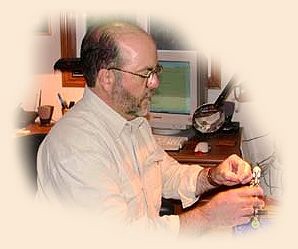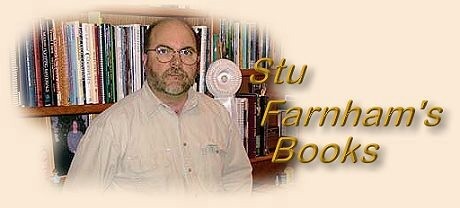|
The Internet is a powerful resource. It provides us instant
access to information, and brings us together via email,
bulletin boards, chat rooms, and instant messaging. FAOL
is a wonderful example of the Internet at its best. The Internet,
however, will never replace the printed page.
I've loved books and fishing since my youngest years, although
I did not start fly fishing until 1993. This column will give
me an opportunity to share reviews of some of my favorite fly
fishing and tying books (and some that are not such favorites)
with my friends here at FAOL. My library reflects my tastes
and interests, and so will this column. It will be heavily
slanted towards cold water fishing and tying for trout and
steelhead, and won't touch much on areas of which I know little,
such as warm or salt water fishing.
I hope that these reviews will motivate some of you to pick up
a good book, on this or any subject, and read.
~ Stu Farnham
Spey and Dee Flies for Steelhead and Salmon: Their History
and Construction
 Spey and Dee Flies for Steelhead and Salmon: Their History
and Construction
Spey and Dee Flies for Steelhead and Salmon: Their History
and Construction
John Shewey
Hardcover: ISBN: 1571882332; (April 2002) $45.00
Paperback: ISBN: 1571882324; (April 2002) $29.95
Frank Amato Publications
This week's column was going to be about a favorite book of
fishing essays. Tom McGuane's The Longest Silence. However,
when I opened my mailbox on Saturday I found a book I had been
waiting for since I pre-ordered a copy from the author in January,
John Shewey's Spey and Dee Flies for Steelhead and Salmon:
Their History and Construction.
As much as I respect the craftsmanship and artistry of full dress
Atlantic Salmon flies, the traditional flies of Scotland's River
Spey hold more appeal for me, both as a fisherman and a fly tier.
Information on these flies - both historical and modern - is scarce;
one of the best sources is found right here on FAOL in Ronn Lucas'
series "How to Dress Atlantic Salmon Flies." Salem, Oregon,
author, fly tier, and seller of tying materials, John Shewey, has
produced the definitive work on these flies, their history, patterns,
and how to tie and fish them.
 Shewey begins his book with a history of Spey and Dee style flies.
This chapter discusses their origins in Europe, their eclipse by
full dress salmon flies, and their reintroduction and popularization
in the United States by Syd Glasso and others.
Shewey begins his book with a history of Spey and Dee style flies.
This chapter discusses their origins in Europe, their eclipse by
full dress salmon flies, and their reintroduction and popularization
in the United States by Syd Glasso and others.
While some reference material can be found on the history of and
patterns for Spey and Dee flies, instruction on tying these patterns
is extremely scarce. This is the area where Shewey makes an outstanding
contribution.
Several chapters deal with materials. Because Spey flies are defined
in part by their long, flowing hackles, a full chapter is devoted to
hackling material. While most tiers associate the use of (now illegal)
heron hackle with Spey files, the original Speys were tied with feathers
from a variety of rooster local to Speyside. John presents a variety
of hackling materials, including schlappen, coque, marabou, blue eared
pheasant, and pheasant rump. He also discusses preparation of hackles,
including the splitting of hackle stems to provide greater flexibility,
less bulk (and improved economy). In the following chapter he discusses
winging materials - low wings, usually of bronze mallard, tented over
the hook are the other distinguishing characteristic of Spey flies - body
materials, and hooks.
Like many of us, Shewey ties flies primarily to be fished, and so
devotes an entire chapter to considerations important to the fisherman:
durability, sinkability, and fishability. Palmered hackle stems are
vulnerable to the sharp teeth of salmon and steelhead, making counter
ribbing of fishing flies critical to their longevity. Steelhead and
salmon tend to hold low in the water column, especially in winter
or during bright daylight, so the ability to get your fly down to
the fish is important.
John provides detailed information on methods for tying Speys and
Dees in the chapters on body construction, hackling, and winging,
providing alternative methods and rationales for choosing one method
over another depending on the tier's intention and available materials.
Finally, he brings all of the pieces together in chapters on tying
traditional Spey and classic Dee flies, with start-to-finish
instructions for several patterns.
As mentioned earlier, the Spey fly revival in the United States
started in the Pacific Northwest, and John is an Oregonian. He
provides a wonderful chapter on the flies and methods of the
early Northwest masters of this craft: Syd Glasso, Dick Wentworth,
Walt Johnson, and John's mentor, Dave McNeese. This is accompanied
by a chapter on the work of contemporary American tiers including
Dec Hogan, Joe Howell, Rich Youngers and others, as well as some
of Shewey's own skillfully crafted flies.
Shewey is an accomplished steelhead fisherman, and, in the
second-to-last chapter of his book, shares his experience and
point of view on fishing for steelhead with flies. He talks
about fly selection, the action of various materials and
tying styles on the action of the fly and the three factors
most critical to steelheading success: reading water,
presentation, and confidence. His point of view on fly
selection is informative; he believes it is important only
to the extent that it provides the fly fisher with confidence
and keeps the fisher's fly in the water.
The book closes with a gallery of dressings by contemporary tiers.
The book is beautifully produced, filled with clear, vibrant
color pictures. The instructional photos are shot against the
usual plain blue background for clarity and to avoid distracting
detail. Most of the fly photos are on various patterned backgrounds,
which offer a nice change from the usual. My hardbound copy came
in a binding which lies flat when opened, which is useful on the
tying table and will help preserve the book.

I have two minor nits with this book. First, there are some critical
instructional bits which could use additional photos for illustration;
I had to reread and then experiment with the technique described
in 'Two Feather Technique for Short Hackles.' Second, I would
have liked to see the work of Steve Gobin, one of my favorite
contemporary tiers, better represented in the book.
In case I have not made my opinion clear, this is an outstanding
book. John Shewey has done a great service to those of us who tie
and fish these classic patterns and their modern descendants. You
can add this one to your Christmas list. However, Christmas is
a long way off, and the summer runs are already underway, so
you may not want to wait.
Next week: Tom McGuane's The Longest Silence (I promise).
~ Stu Farnham
About Stu
 Stu Farnham is a New Englander by birth, who was transplanted to
and put down roots in Oregon in the early 1990s. A software
engineering manager by vocation, he can be found in his spare
time chasing trout and steelhead in the rivers of the Pacific
Northwest, chasing his four Gordon Setters (who in turn are
chasing chukar), tying flies, reading, or working on his website.
Colleen, his long suffering wife of 28 years, is a professionally
trained personal chef.
Stu Farnham is a New Englander by birth, who was transplanted to
and put down roots in Oregon in the early 1990s. A software
engineering manager by vocation, he can be found in his spare
time chasing trout and steelhead in the rivers of the Pacific
Northwest, chasing his four Gordon Setters (who in turn are
chasing chukar), tying flies, reading, or working on his website.
Colleen, his long suffering wife of 28 years, is a professionally
trained personal chef.
|

 Spey and Dee Flies for Steelhead and Salmon: Their History
and Construction
Spey and Dee Flies for Steelhead and Salmon: Their History
and Construction Stu Farnham is a New Englander by birth, who was transplanted to
and put down roots in Oregon in the early 1990s. A software
engineering manager by vocation, he can be found in his spare
time chasing trout and steelhead in the rivers of the Pacific
Northwest, chasing his four Gordon Setters (who in turn are
chasing chukar), tying flies, reading, or working on his website.
Colleen, his long suffering wife of 28 years, is a professionally
trained personal chef.
Stu Farnham is a New Englander by birth, who was transplanted to
and put down roots in Oregon in the early 1990s. A software
engineering manager by vocation, he can be found in his spare
time chasing trout and steelhead in the rivers of the Pacific
Northwest, chasing his four Gordon Setters (who in turn are
chasing chukar), tying flies, reading, or working on his website.
Colleen, his long suffering wife of 28 years, is a professionally
trained personal chef.
 Shewey begins his book with a history of Spey and Dee style flies.
This chapter discusses their origins in Europe, their eclipse by
full dress salmon flies, and their reintroduction and popularization
in the United States by Syd Glasso and others.
Shewey begins his book with a history of Spey and Dee style flies.
This chapter discusses their origins in Europe, their eclipse by
full dress salmon flies, and their reintroduction and popularization
in the United States by Syd Glasso and others.